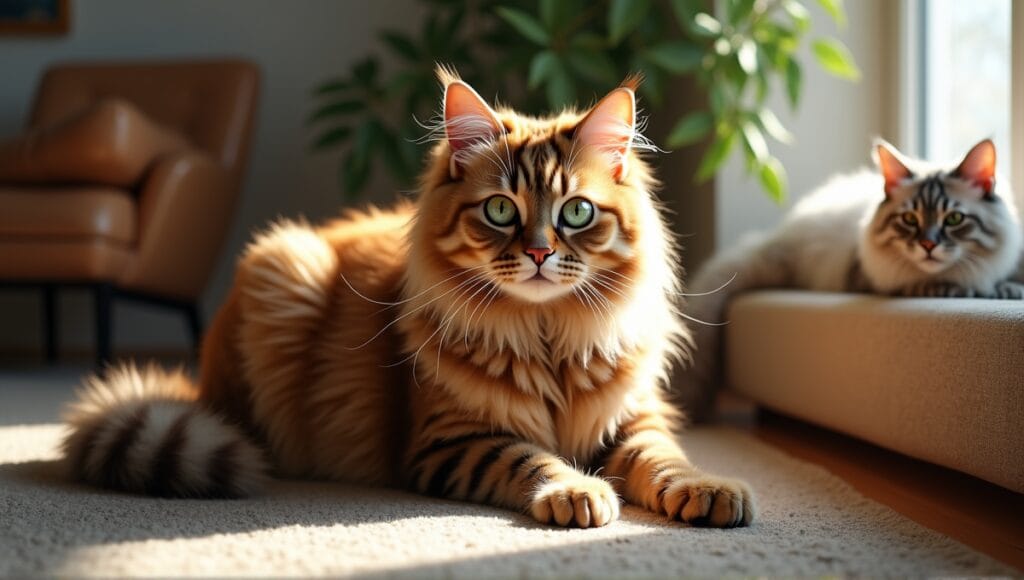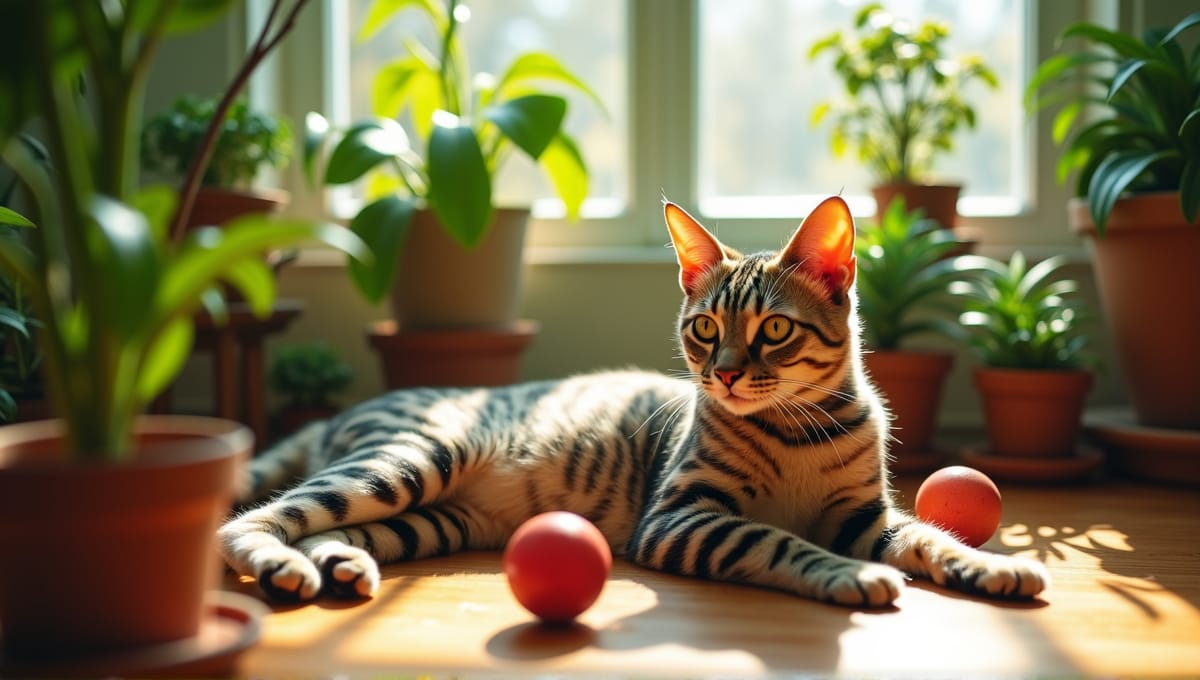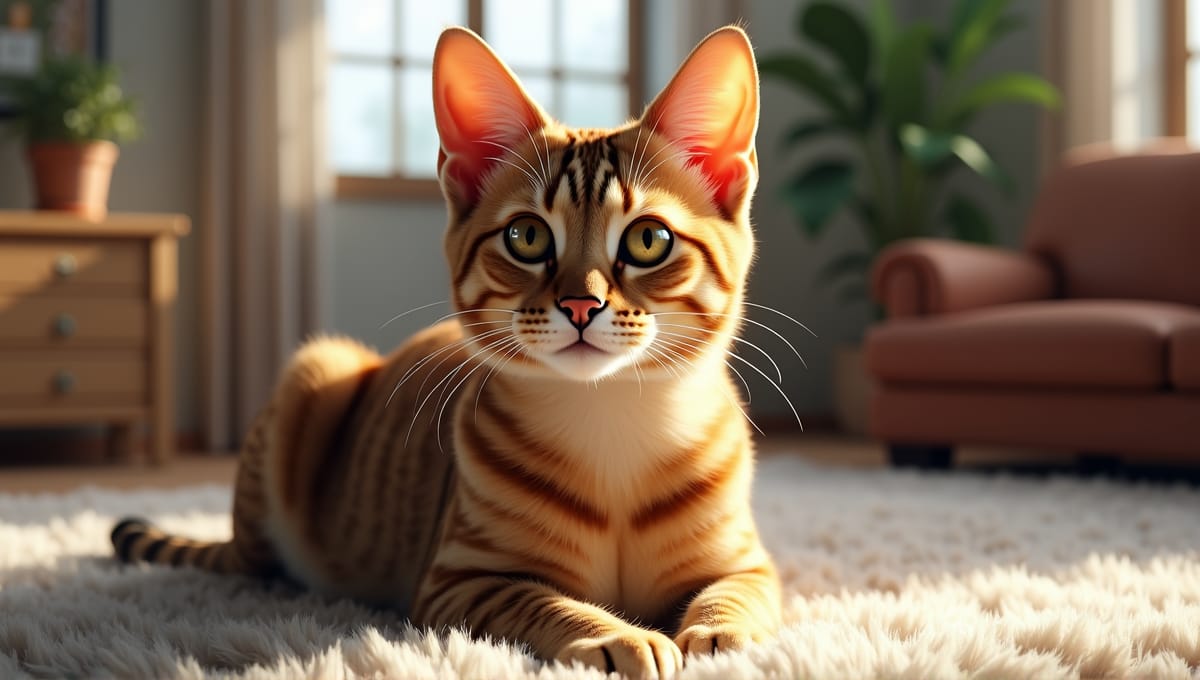I’ve been a cat owner my entire life, and I can attest that not all cats are the same size. Some domestic cats are giants in comparison to the average house cat. So, what are the largest domestic cat breeds? I’ll share the inside scoop on these amazing cats. So without further ado, let’s discuss big cats that you can have as pets!
Largest Domestic Cat Breeds

You’ve likely encountered some impressive cats in your day, but let me introduce you to the largest domestic cat breeds. As someone who has been around cats of all shapes and sizes for years, I can confirm these breeds are truly extraordinary.
Maine Coon cats are often referred to as the “gentle giants,” and with good reason:
- They can grow to be 40 inches in length.
- Males typically tip the scales at 13 to 18 pounds.
- You can spot them from a mile away thanks to their ear tufts and the bushiest of tails.
- Despite their size, they have a reputation for being very sweet and friendly.
Savannah cat breed cats are a wild hybrid that are quite the spectacle:
- An F1 Savannah can reach up to 30 pounds!
- Their long legs and spotted coats make them look like a small leopard.
- They are extremely active and smart.
Ragdolls are another large, mellow breed that lives up to its name:
- Males of the breed weigh 15 to 20 pounds.
- Their bright blue eyes and color point coats are their most defining physical characteristics.
- These cats adore being held and will often go limp in your arms!
Siberian cats are a big breed that’s also known for being hypoallergenic:
- They typically tip the scales at 10 to 20 pounds.
- Their thick triple coat contains surprisingly low levels of allergens.
- They’re both playful and loving with their families.
Norwegian Forest cats are a robust, noble breed:
- Males can weigh up to 16 pounds.
- Their double coat is water resistant, making it the ideal coat for surviving Norwegian winters.
- They’re independent yet loving companions.
These breeds are certainly impressive, but it’s important to remember that size isn’t the only factor to consider. Each cat has its own personality and needs. While size is one thing to keep in mind, it’s important to consider other traits as well to ensure you select the right cat for you.
Physical Characteristics of Large Domestic Cats

When discussing large house cats, we’re talking about some hefty measurements. Let’s quantify it.
Lengthwise, these cats are impressive. Maine Coons and Ragdolls can measure 40 inches from nose to the tip of the tail. That’s longer than many small dog breeds! They vary in height, but Savannahs take the prize. They can measure 22 inches at the shoulder.
Weight ranges are equally as notable. Male Maine Coons can weigh 18 pounds or more. Females are a bit lighter, typically weighing anywhere from 8 to 12 pounds. Savannahs, particularly F1s, can top 25 pounds.
Each of these large breeds boasts some unique features. Maine Coons have tufted ears and fluffy tails. Savannahs have elongated legs and a spotted coat that resembles their wild ancestors. Ragdolls have piercing blue eyes and colorpoint coats that will stop passersby in their tracks.
Each breed follows a different growth pattern. Maine Coons grow at a steady pace, not reaching full size until they’re 3 to 5 years old. Other large breeds like Ragdolls complete most of their growing by 4. It may seem like a long time, but it’s certainly a reward to see these impressive cats at their maximum size.
The Maine Coon: King of Domestic Cats

Maine Coons are arguably the royalty of the domestic cat world. I’ve been fortunate enough to own a few, and I’m always amazed by their sheer size.
Male Maine Coons can weigh in at a whopping 18 pounds, and females generally tip the scales at 8-12 pounds. These cats can reach a maximum length of 40 inches from the tip of the nose to the tip of the tail. Talk about a massive kitty!
In addition to their size, Maine Coons have some other unique physical characteristics. They have adorable tufted ears that give them a lynx-like appearance. Their long, shaggy fur comes in several different colors and patterns. You can always identify a Maine Coon by their thick, bushy tail that’s sometimes as long as their body.
Despite their size, Maine Coons are incredibly gentle and sweet cats. They’re often referred to as “gentle giants,” and for good reason. Maine Coons tend to get along with just about everyone, including children and other animals.
While Maine Coons make great pets, they do require more maintenance than other cats. Their long hair needs to be brushed regularly to prevent matting. They also need plenty of space to roam and climb. You’ll want to invest in some large, sturdy cat trees. Finally, keep in mind that Maine Coons adore water. Therefore, don’t be too shocked if your cat tries to hop in the shower with you!
Savannah Cats: A Touch of the Wild

Savannah cats are one of the closest things to bringing a wild cat into your home. I’ve personally worked with these amazing hybrids, and they definitely don’t behave like any other domestic cat.
First generation Savannah cats, also known as F1 Savannahs, can weigh as much as 25 pounds and stand up to 22 inches at the shoulder. That’s taller than many small dog breeds! Later generations are smaller, though they’re still larger than the average domestic cat.
Savannah cats have an incredible amount of energy. They’re very active, playful, and intelligent. Savannahs require a lot of stimulation and interactive play, and without it, they can become bored and destructive.
It’s also important to note that Savannah cats aren’t legal in all areas. Many states and countries have restrictions, particularly on early generation Savannah cats. Always research your local laws before considering one as a pet.
Savannah cats also have specific care requirements. They need a high protein diet to sustain their active lifestyle and plenty of vertical space to climb. Additionally, these cats are notorious escape artists, so be prepared to build secure enclosures if you want to let them roam outdoors.
Ragdolls: Gentle Giants
Ragdolls are another breed that I have a soft spot for. I’ve watched many of these gentle giants grow from tiny kittens into impressive adults.
Male Ragdolls can weigh 15-20 pounds, and females are usually 10-15 pounds. Ragdolls can grow up to 40 inches long. That’s a whole lot of cat to cuddle!
One of their most distinguishing features is their coats. Ragdolls have semi-long, silky fur and come in six primary color patterns. Additionally, all Ragdolls have beautiful blue eyes that really pop against their coat colors.
As their name suggests, Ragdolls are famous for their relaxed, floppy nature. They have a tendency to go limp when you pick them up, which is how they earned the breed name. They’re generally very relaxed, friendly, and good with children and other animals.
Despite their long fur, Ragdolls are surprisingly easy to groom. Their fur doesn’t mat very often, but regular brushing will help keep it in great condition. They are seasonal shedders, so you may notice a little extra fluff during these times.
Other Large Domestic Cat Breeds

While Maine Coons Savannahs, and Ragdolls often take the cake, there are other excellent large cat breeds to consider.
Siberian cats are a healthy, allergy-friendly option:
- They weigh 10-20 pounds on average
- Their dense triple coat contains surprisingly few allergens
- They’re playful, loving, and excellent climbers
Norwegian Forest cats are a strong, regal breed:
- Males weigh up to 16 pounds
- They have a double coat that’s water resistant
- They’re independent and affectionate cats
Chausie cats are a large, athletic, exotic breed:
- They can weigh up to 30 pounds
- Chausies look wild due to their jungle cat ancestors
- They have high energy levels and require plenty of exercise
American Bobtails are a muscular breed known for their distinctively short tails:
- They weigh 7-16 pounds on average
- Their feral appearance contrasts with their friendly, sweet nature
- These cats are famous for their dog-like dispositions
Turkish Vans are an energetic, quirky breed:
- They weigh up to 18 pounds
- They adore water and are often referred to as “the swimming cat”
- Turkish Vans are playful and intelligent breeds
Each breed has its own appeal. All of these breeds necessitate specific care and adequate space to live a healthy life.
Health Considerations for Large Domestic Cats
Caring for larger cat breeds requires some special health considerations. I’ve personally witnessed how proper care has significantly improved these cats’ lives.
Larger cats are more prone to certain health issues. For example, hip dysplasia and hypertrophic cardiomyopathy are more common in breeds like Maine Coons and Ragdolls. Regular vet check-ups are important to identify and treat these issues early.
Their diet is the primary factor in controlling weight. Obesity is a major issue in larger cats because it can lead to joint problems and diabetes. Feeding them a diet of high-quality protein is important, and you’ll also want to ensure they’re not overeating. Even if your cat is constantly begging for food, it’s important to control portions!
Exercise is just as important as diet. Larger cats need a lot of play and climbing time. You can use interactive toys, puzzle feeders, and cat trees to help them stay active and mentally engaged.
Keep in mind that every cat is different. What works for one may not work for another. Always ask your vet for the best health care plan for your larger cat.
Accommodating Large Cats in Your Home

Making a few adjustments to your home can accommodate the needs of a large cat breed. And trust me, it’s worth making these adjustments to ensure these amazing cats are happy and comfortable.
Space is essential. Large cats need plenty of room to stretch their legs and run around. If you live in a small apartment, your Maine Coon or Savannah cat may feel cramped. You should also think vertically. Large cat trees or wall-mounted shelves gives your cat the opportunity to climb.
All of your furniture should be sturdy enough to support a large cat breed. Look for cat trees with a wide base and thick posts. The scratching post should also be tall enough to allow your cat breed to fully stretch while scratching.
You’ll also need to carefully consider the litter box. These large cat breeds will need a larger area to go to the bathroom. Some of my clients have had success using plastic storage containers as litter boxes for these cats. Additionally, make sure you’re scooping at least once a day, as these large cats will produce a lot of waste.
Another key consideration is the feeding station. You should elevate the food station to allow your cat to eat comfortably. I also recommend heavy ceramic bowls that won’t easily tip over. And for water, consider a cat fountain. Many cat breeds, especially Maine Coons, love moving water.
By making these adjustments, your large cat breed will feel right at home. And it’s truly amazing to watch these cats utilize the space you’ve created for them.
Choosing the Right Large Cat Breed for You

Selecting the best large cat breed for you is a big decision. I’ve helped many cat enthusiasts make this decision, and there are a few things to think about.
First, consider your lifestyle. Active breeds, such as Savannahs, require lots of play and interaction. If you’re frequently out of the house, a more independent breed, like the Norwegian Forest Cat, may be a better fit.
Home size also matters. While all large breeds require a larger than average amount of space, some breeds, like Maine Coons and Ragdolls, can adapt to small living spaces if you provide them with plenty of vertical space.
Also, think about the financial considerations. Large cats will eat more and may have higher veterinary bills. In addition, certain breeds, such as the Savannah, are more expensive to purchase upfront.
Do your due diligence. Research reputable breeders and consider looking for breed-specific rescues. If you do visit a breeder, always go in person, spend time with the cats, and ask plenty of questions.
Finally, keep in mind that every cat (even within a breed) is different. Be patient and don’t rush the process of finding the perfect cat for you and your family.
Myths and Facts About Large Domestic Cats

There are plenty of misconceptions about big cat breeds. Let’s discuss what’s true and what’s not.
Myth: Big cats are aggressive.
Reality: Most large cat breeds are known for their docile temperament. Maine Coons and Ragdolls are often referred to as “gentle giants”.
Myth: Big cats are untrainable.
Reality: The Savannah, a larger cat breed, is particularly intelligent and can be trained.
Myth: Big cats have shorter lifespans.
Reality: Many of the larger cat breeds, with the right care, live 12-15 years or longer.
Myth: Big cats are always destructive.
Reality: While they will be more destructive if confined to a small space, owning the appropriate toys and scratching posts can control this behavior.
I’ve seen these misconceptions hold people back from getting a cat. The reality is that larger cat breeds can be great pets as long as you understand their needs and can meet them. They’re not the right choice for everyone, but for those that can accommodate them they offer a unique and enjoyable pet.
If you’re interested in learning more about different cat breeds, you might want to check out our articles on exotic cat breeds and low-maintenance cat breeds. These can provide more information to help you choose the right cat for your lifestyle.
In Summary
Large domestic cat breeds are the perfect mix of size and personality. These larger cats are gentle and excellent pets for the right people. Just keep in mind that larger cats require more space, proper food and regular vet visits, so do your homework before adopting one. Yet if you prepare correctly, a large cat can be an incredible addition to the family for many years. And your feline buddy will thank you with plenty of love and entertainment.






